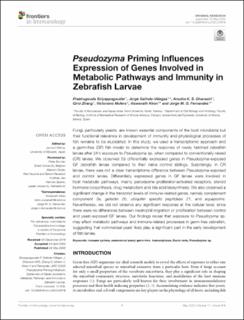Pseudozyma priming influences expression of genes involved in metabolic pathways and immunity in zebrafish larvae
Siriyappagouder, Prabhugouda; Galindo-Villegas, Jorge; Dhanasiri, Anusha; Zhang, Qirui; Mulero, Victoriano; Kiron, Viswanath; Fernandes, Jorge Manuel de Oliveira
Peer reviewed, Journal article
Published version
Permanent lenke
https://hdl.handle.net/11250/2663667Utgivelsesdato
2020Metadata
Vis full innførselSamlinger
Originalversjon
Siriyappagouder, P., Galindo-Villegas, J., Dhanasiri, A. K. S., Zhang, Q., Mulero, V., Kiron, V. & Fernandes J. M. O. (2020). Pseudozyma priming influences expression of genes involved in metabolic pathways and immunity in zebrafish larvae. Frontiers in Immunology, 11: 978. doi: 10.3389/fimmu.2020.00978Sammendrag
Fungi, particularly yeasts, are known essential components of the host microbiota but their functional relevance in development of immunity and physiological processes of fish remains to be elucidated. In this study, we used a transcriptomic approach and a germ-free (GF) fish model to determine the response of newly hatched zebrafish larvae after 24 h exposure to Pseudozyma sp. when compared to conventionally-raised (CR) larvae. We observed 59 differentially expressed genes in Pseudozyma-exposed GF zebrafish larvae compared to their naïve control siblings. Surprisingly, in CR larvae, there was not a clear transcriptome difference between Pseudozyma-exposed and control larvae. Differentially expressed genes in GF larvae were involved in host metabolic pathways, mainly peroxisome proliferator-activated receptors, steroid hormone biosynthesis, drug metabolism and bile acid biosynthesis. We also observed a significant change in the transcript levels of immune-related genes, namely complement component 3a, galectin 2b, ubiquitin specific peptidase 21 and aquaporins. Nevertheless, we did not observe any significant response at the cellular level, since there were no differences between neutrophil migration or proliferation between control and yeast-exposed on GF larvae. Our findings reveal that exposure to Pseudozyma sp. may affect metabolic pathways and immune-related processes in germ-free zebrafish, suggesting that commensal yeast likely play a significant part in the early development of fish larvae.

